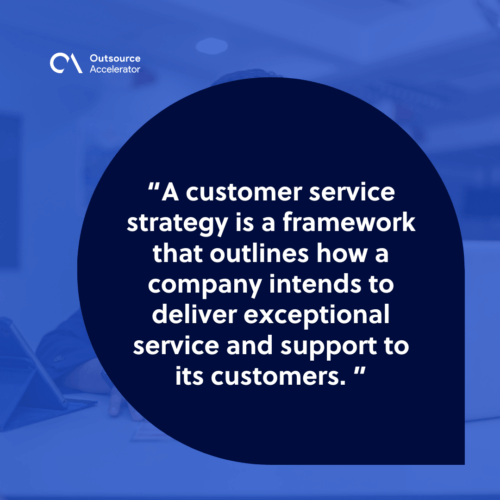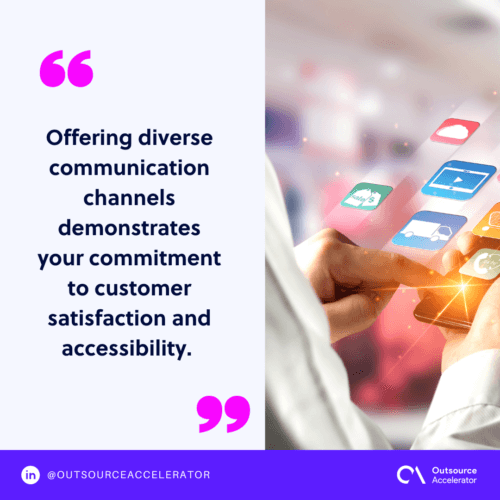How to develop a winning customer service strategy

Providing exceptional customer service is no longer just a nice-to-have but a crucial component of success.
To strengthen this initiative, companies must first develop a well-defined customer service strategy. This will help them differentiate themselves from others, retain loyal customers, and create meaningful and lasting connections that boost business growth.
This article dives into the essential steps involved in creating a comprehensive customer service tactic. These steps form a plan that aligns with your goals, empowers your team, and leaves a lasting impression on your customers.
What is a customer service strategy?
A customer service strategy is a framework that outlines how a company intends to deliver exceptional service and support to its customers.
It encompasses a set of guiding principles, goals, and actions that contribute to monitoring and improving the customer experience. It’s designed to ensure that every interaction is positive, consistent, and in line with the overall business objectives.

How to develop an effective customer service strategy
Crafting a customer service strategy is a complex process that considers various aspects of the customer experience.
Here are some of its essential steps:
1. Understand your customers’ needs
The first step is to gather insights and data about your customers.
You must conduct thorough research to identify these elements:
- Demographics
- Preferences
- Behaviors
- Pain points
By using methods like surveys and interviews, you gain data that you can use to tailor your service approach to meet their specific requirements.
2. Determine your customer service goals
Once you’ve identified your customer needs, it’s essential to clearly define your customer service strategy’s objectives.
The SMART framework will help you craft business objectives that are:
- Specific
- Measurable
- Achievable
- Relevant
- Time-bound
Clear objectives provide a roadmap for your customer service efforts and help ensure that your teams are working towards common goals.
3. Map the customer journey
Mapping out the customer journey is crucial for delivering a consistent experience across all touchpoints.
Identify the key stages in the customer lifecycle from initial contact to post-purchase support. Map out the interactions that customers are likely to have with your brand at each stage.
Also, consider the different channels they’ll use to do so. This way you can anticipate their needs and personalize opportunities.
4. Leverage technology and tools
When used as a potent ally, technology can provide outstanding customer service.
Utilize solutions like:
- CRM software
- Self-service portals
- Help desk software
- Live chat platforms
These tools can assist in providing information and addressing customer needs around-the-clock.
5. Establish communication channels
It’s helpful to provide multiple communication channels to meet customers where they are and give them convenient access to support.
These channels can take the following forms:
- Phone support
- Live chat
- Social media messaging
Offering diverse communication channels demonstrates your commitment to customer satisfaction and accessibility.

6. Measure and improve performance
Continuously monitoring and evaluating your customer service strategy lets you identify gaps and opportunities for improvement.
Recruiting feedback from customers and teams allows you to distinguish what is working and what needs to be changed.
In this manner, you can ensure that your customer service strategy remains effective and responsive to evolving customer needs.
Importance of a customer service strategy
An effective customer service strategy is of high importance for businesses across all industries due to several key reasons:
Customer satisfaction
A well-defined customer service strategy helps businesses deliver exceptional experiences that meet or exceed customer expectations. Your audience will appreciate timely assistance, prompt issue resolution, and personalized service.
Competitive advantage
A crowded marketplace means that products and prices can often be similar. Providing exceptional customer service can be a crucial differentiator.
A well-defined customer service strategy lets you deliver exceptional experiences that customers will appreciate. This serves as your competitive edge against other brands.
Brand reputation
Customer service plays a significant role in shaping a company’s reputation. Satisfied customers are more likely to share their experiences with others, leading to positive word-of-mouth and referrals.
On the contrary, a poor customer service strategy can quickly damage your reputation, deterring people from engaging with your business.
Customer retention
Positive customer experiences contribute to higher retention rates. When businesses consistently deliver excellent service and support, customers are more likely to remain loyal and continue patronizing the brand.
Revenue growth
Because you have a reliable pool of loyal customers, this will lead to a steady revenue stream. They are likely to make repeat purchases and spend more over their lifetime.
Additionally, this also opens up opportunities for upselling and cross-selling, further driving sales and profitability.
Employee engagement
A customer-focused strategy also benefits employees. When employees see the impact of their efforts on customer satisfaction, it can motivate them more.
Take advantage of this by empowering them with the necessary tools, training, and authority to increase their engagement.

Offshore skilled customer service teams with ConnectOS
Build an offshore customer service team with ConnectOS! With its integrated resourcing solutions, ConnectOS helps businesses of all sizes find the right talent quickly and effortlessly.
ConnectOS does offshoring differently, allowing you to completely focus on your team’s day-to-day work. Transform your business and partner with them today to deliver remarkable customer service.







 Independent
Independent




